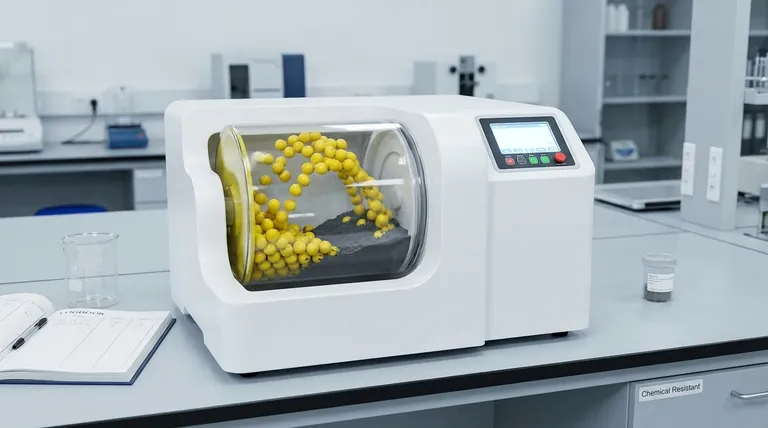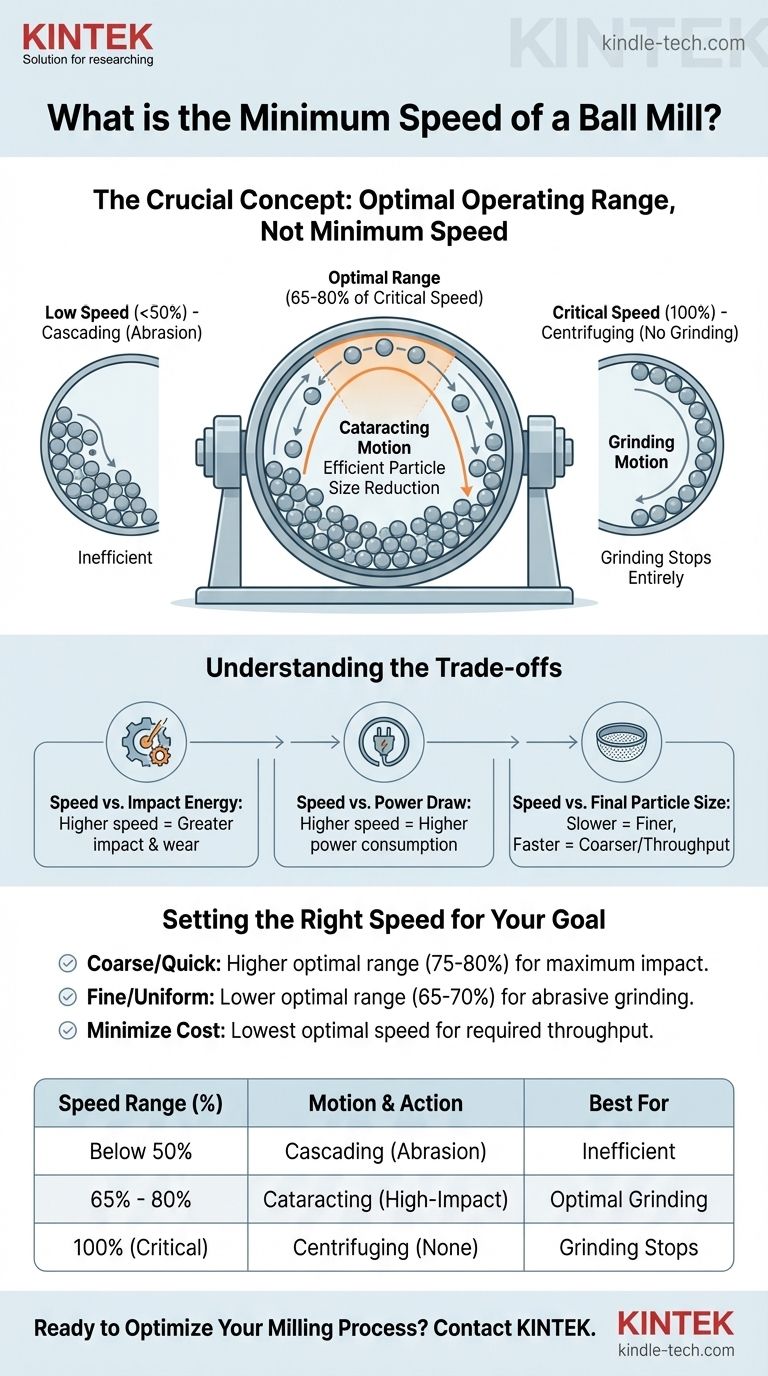While there isn't a single universal "minimum speed", the effective operation of a ball mill is governed by a concept called critical speed (Nc). A ball mill must operate at a specific percentage of this critical speed to function. Operating too slowly results in inefficient grinding, while operating too fast causes the grinding to stop entirely.
The crucial concept is not a minimum speed, but an optimal operating range. This range is typically between 65% and 80% of the mill's "critical speed"—the theoretical speed at which the grinding media would stick to the mill wall and cease to grind.

Deconstructing Ball Mill Speed: Critical vs. Operating
To understand how a ball mill works, you must distinguish between the theoretical limit (critical speed) and the practical, effective speed (operating speed).
What is Critical Speed (Nc)?
Critical speed is the theoretical rotation speed where the centrifugal force acting on the grinding media perfectly balances the force of gravity.
At this speed, the balls or rods are pinned against the inner wall of the mill, rotating with it as a single mass. No tumbling or impact occurs, and therefore, grinding completely stops. It is a maximum speed limit, not a target to be reached or exceeded.
The Practical "Minimum" - Cascading Motion
At very low speeds, typically below 50% of critical speed, the grinding media is lifted only slightly by the mill's rotation before it tumbles down the surface of the other media.
This motion is called cascading. It produces grinding action primarily through abrasion (rubbing), which is inefficient for breaking down larger particles. While technically a "minimum" speed for any action, it is rarely the desired state.
The Optimal Speed Range - Cataracting Motion
The most efficient grinding happens in the optimal operating range, generally between 65% and 80% of the critical speed.
In this range, the media is carried further up the side of the mill until it breaks away and follows a parabolic path, crashing down onto the material at the bottom. This is called cataracting. This motion provides the high-impact energy needed for effective and rapid particle size reduction.
Understanding the Trade-offs
Choosing a speed is not arbitrary; it involves balancing competing factors to achieve a specific outcome.
Speed vs. Impact Energy
As you increase speed within the optimal range (from 65% toward 80% of Nc), the media is thrown higher and farther.
This results in greater impact energy, which is ideal for breaking down hard, coarse materials. However, it also significantly increases the rate of wear on both the grinding media and the mill's internal liners.
Speed vs. Power Draw
The power required to turn the mill increases with speed, reaching its peak just below the critical speed.
Operating at the highest possible speed is not always the most energy-efficient choice. It can lead to higher operational costs for only marginal gains in throughput.
Speed vs. Final Particle Size
Slower speeds that favor cascading create more abrasive action, which can be beneficial for producing a very fine final product.
Conversely, higher speeds that create cataracting are better for coarse crushing and maximizing throughput, but may produce a wider particle size distribution.
Setting the Right Speed for Your Goal
Your ideal speed depends entirely on your operational objectives. Use the critical speed of your specific mill as the benchmark and adjust from there.
- If your primary focus is breaking down coarse material quickly: Operate in the higher end of the optimal range (around 75-80% of critical speed) to maximize impact forces.
- If your primary focus is producing a very fine, uniform product: Consider operating in the lower end of the optimal range (around 65-70% of critical speed) to favor abrasive grinding over high impact.
- If your primary focus is minimizing wear and energy costs: Operate at the lowest speed within the optimal range that still achieves your required throughput and particle size reduction.
Ultimately, finding the correct mill speed is a strategic decision that balances throughput, final particle size, and operational cost.
Summary Table:
| Speed Range (% of Critical Speed) | Motion Type | Primary Grinding Action | Best For |
|---|---|---|---|
| Below 50% | Cascading | Abrasion (Rubbing) | Inefficient; rarely used |
| 65% - 80% | Cataracting | High-Impact Energy | Efficient particle size reduction (Optimal Range) |
| 100% (Critical Speed - Nc) | Centrifuging | None | Grinding stops entirely |
Ready to Optimize Your Milling Process?
Choosing the right ball mill speed is crucial for your lab's productivity and efficiency. KINTEK specializes in high-performance lab equipment, including ball mills, to help you achieve precise particle size reduction and maximize your throughput.
Contact our experts today to discuss your specific grinding needs and discover how KINTEK's solutions can enhance your laboratory's capabilities and reduce operational costs.
Visual Guide

Related Products
- Laboratory Single Horizontal Jar Mill
- High Energy Planetary Ball Mill Milling Machine for Laboratory
- High-Energy Omnidirectional Planetary Ball Mill Milling Machine for Laboratory
- High-Energy Omnidirectional Planetary Ball Mill Machine for Laboratory
- High Energy Planetary Ball Mill Milling Machine for Laboratory
People Also Ask
- Why are zirconia (ZrO2) milling jars recommended for sulfide electrolytes? Ensure Purity in Li6PS5Cl Synthesis
- Why use zirconia ball milling jars for SiC/ZTA composite powders? Ensure High Purity & Efficient Particle Refinement
- What is the product size of a ball mill? Achieve Micron-Level Precision for Your Materials
- Why are silicon nitride or zirconia preferred for milling iodo-vanadate-lead precursors? Ensure High Purity Results
- What is a ball mill used for in ceramics? Achieve Ultimate Control Over Glaze and Clay Quality



















